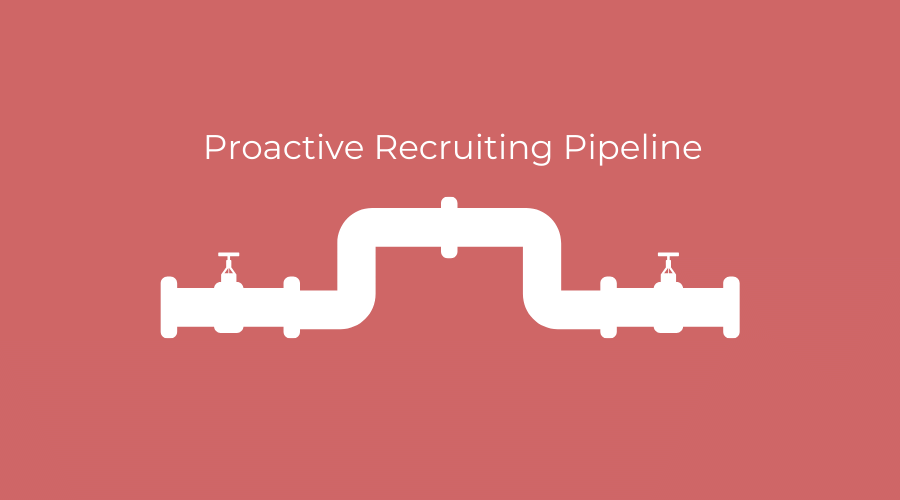Awhile back many organizations made a switch from using the term “recruitment” to “talent acquisition”. Talent Acquisition is not only a catchy phrase and continues to gain popularity, but it signifies a different approach because it is an ongoing strategy to find specialists, leaders, or future executives for your company. Building a talent pipeline requires time and effort.
Recruitment tends to focus on filling vacancies, being transactional and concentrating on immediate actions and short-term goals. Think of the hours spent reviewing applications received through an open requisition and only using that limited pool of candidates to make a critical hiring decision, versus selecting someone who truly is a great fit.
Having the title of recruiter does not mean you aren’t strategic and don’t have a long-term strategy to find talent. However, so many recruiters are burdened with high workloads, administrative tasks and time draining activities that they don’t have enough time in the day to do higher level work. The best recruiters focus on building strong, proactive talent pipelines.
It takes time and an understanding of the long-term staffing needs of the organization, but once in place, your organization can reap the rewards of having a proactive recruiting pipeline. It’s what the best executive search firms do, so why not do it within your organization?
What is a talent pipeline?
Creating a talent pipeline is the process of identifying and engaging with candidates long before a position comes open – they’re not actually “candidates”. Rather, they’re people you are building a relationship with who have the essential skill set required in frequently hired and key positions within your organization.
So, when a position is available in a few months or even years, you have a proactive talent pipeline of people who can fill the role quickly and, more importantly, will excel in the role and want to join your company.
A recruiting pipeline:
- Significantly reduces the time to hire. Hard to fill roles typically taking over 3 months to fill can be filled as soon as the position officially becomes open. This can be extremely important in sensitive roles where a project can’t go forward without the people with the necessary skills to do the work.
- Reduces the aggravations of a standard hiring process such as scheduling interviews with different stakeholders and spending needless time on unqualified candidates, when no one has any extra time.
- Increases the likelihood of the retention and long-term success of the new hire. During the time you have been building the relationship with someone in the pipeline, that person is also learning about the organization and seeing how they’ll fit in for the long term. So once the position is open, there’s less convincing about why to join, and more of a celebration about becoming part of the team.
Talent pipelines require relationship building:
- Relationships are ingrained in who we are as people. Relationships matter and help people in making decisions. So, if you have taken the time to build trusting relationships with people who have the skills your organization needs, when someone who has a choice to work for multiple companies, they will more than likely choose your organization versus going through a standard transactional recruitment process where the candidate applies, goes through the interview steps and maybe becomes an employee. Plus, the candidate can trust they are making a great decision given you’ve been talking to them professionally for years.
-
- Talent pipelines are built over many years. In order to meet people, you need to attend networking events, industry trade shows, ask for introductions, personalize your content to job boards and resume databases, be responsive and accessible.
- Talent acquisition is a relationship business not a transaction or a metric
What’s keeping you from building a talent pipeline?
- Screening unqualified resumes (typically only 10% of resumes received meet job requisition qualifications).
- Sourcing candidates for an immediate fill due to lack of applicants to your job posting.
- Interview logistics.
- An overload of open requisitions.
- Not enough time since the task work interferes with the strategic work.
How to solve the dilemma?
It’s now easier and more affordable than ever, to automate the things that are repetitive, time drains and overwhelming.
That’s the beauty of AI (artificial intelligence). AI can easily and more accurately handle the top-of-funnel sourcing, screening candidates and answering common questions. It’s not about taking jobs away so much as freeing up recruiters to do more valuable work, like relationship building!
With more time, go to a seminar, network, reach out to people to set up a time to talk and learn more about someone you recently met. Maybe they love their current job and boss and there are no opportunities with your company for them right now. But things can change in a few months. Businesses, organizations, work situations, people are constantly changing and evolving. With a strong talent pipeline in place, you can be ready and in better control for the constant changes in the workplace and talent needs.
Use AI to get more time. Then you use the time to be more strategic. That’s how you replace “transactional” with “adding value”.


